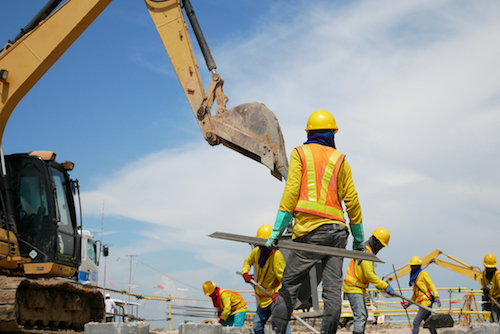
5 Ways to Stay Safe on a Construction Site

With more and more young people starting careers in construction for the good pay, benefits, and advancement options, it’s vital that everyone on site is well versed in basic construction safety.
Here are five simple, but important, ways to remain safe when working with heavy equipment on a construction site:
1. Don’t Forget Your Protective Gear
Active construction sites are undeniably dangerous places to be. Before you even set foot on one, be sure to put on any appropriate protective gear.
Part of your education at West Coast construction will include how to properly utilize your safety gear, as well as how to adjust what you use to better fit each individual situation. In an environment as hazardous as a construction site, preparation is key to safety.
Hard hats should be worn at all times when on site. You never know when someone will accidentally drop a tool or when a piece of debris might come loose right above you. Low hanging equipment and electrical wiring are also huge dangers; you really don’t want to run into those head first!
Proper footwear is also imperative, although easily overlooked. You’ll need a good, sturdy pair of either steel-toed or composite-toed boots to both protect your feet and give you good traction.
Safety glasses shouldn’t be forgotten, particularly if you’re going to be working with power tools. Finally, get some sturdy work gloves! After a long day working on site, your hands will thank you.
2. Stay Safe in the Sun
When you’re surrounded by power tools and heavy equipment machinery, it’s easy to forget how dangerous it is being out in the sun. We offer hands-on education, so you will know what it’s like to work outside all day long. Exhaustion, dehydration, and skin cancer are serious risks to anyone working in the construction industry. If you’re going to be working out on site all day long, you’ll need to take the proper precautions.
Apply sunscreen, and apply it often. Regular use of sunscreen will reduce your risk of skin cancer significantly, so make it part of your work routine. Keep some on site and you’ll never have to worry about forgetting it.
Stay hydrated, particularly on those hot summer days. It’s not hard to carry a bottle of water with you, so get in the habit of drinking water while you work. Try to avoid other drinks like coffee, soda, or energy drinks, as high sugar and caffeine can dehydrate you even more.
On days when the temperature breaks into the hundreds, regulations from the Occupational Safety and Health Administration (OSHA) require additional safety measures. Take plenty of breaks in the shade, drink additional water, and know who to turn to if you or anyone else begins exhibiting symptoms of heat-related illness.
Part of your job is taking care of yourself, so be prepared and know your limits.
3. Build the Right Habits
There is a right way and a wrong way to do everything. On a construction site, doing things the wrong way can have serious consequences.
Part of proper safety procedure is building the right habits, ensuring you’re not taking unnecessary risks, or causing yourself prolonged harm. Safe habits start small, so learn the basics and start early.
Good posture and lifting techniques are key to maintaining your physical health long term, so don’t forget to stand up straight and lift with your knees. Some people find daily exercise and stretching helpful for maintaining good physical form, as well as for cutting down on aches and pains at the end of the day.
Be careful when working on scaffolding, particularly when climbing up or down the side. Don’t attempt to climb or work from scaffolding without proper fall protection training and gear. Keep at least three points of contact with the scaffold itself, and don’t lean away from the structure while climbing. Misplaced body weight can tip over scaffolding, bringing you painfully back down to earth. Additionally, don’t put your weight anywhere not specifically designed to handle it. Just because you think it’s sturdy, doesn’t mean it is.
4. Minimize On-Site Distractions
When working on a construction site, you need to keep your undivided attention on the task at hand. There is simply no place for a wandering mind when you are using site equipment or working with heavy machinery. Removing and avoiding distractions helps everyone stay present and engaged in what they’re doing, making the site safer overall. At West Coast construction, we can help you build the discipline you need to keep your mind focused.
First and foremost: get off your cell phone! It may feel like you’re missing an appendage at first, but your phone is almost certain to pull your focus away when it is needed most. Put it on silent, turn it off, or even leave it somewhere else to avoid the distraction altogether. Your notifications and texts can wait until you’re off-site.
If you have a radio on site, don’t let it drown out other people. Music can make your day go by faster, but awareness is key to safety on an active construction site. If you cannot easily hear everyone and everything around you, it’s more difficult to remain safe.
Remember: everyone on site is responsible for each other’s safety. Do your due diligence and stay alert.
5. Get Trained on Safety
Proper construction safety is something best learned before even setting foot on a site. Your safety knowledge is the first line of defense from accidents and injuries, and its importance cannot be overstated.
We’re happy to help you build the foundation of your safety practices.
After you learn the fundamentals, stay ready to adapt and grow as safety practices and regulations change. There is always more to learn, each piece of information minimizing the risk to you and those around you. Start your education today and step onto the site with confidence in your safety skills.
